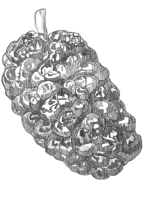Mulberry

- Mulberry wood is highly valued. For example, in Central Asia it is used to make musical instruments and in China it is used to make valuable paper.
- Only male trees produce pollen that can trigger an asthmatic attack. Female trees, on the contrary, pull it out of the air and have the lowest level of allergic potential.
- The main difference between white and black mulberries is not the color of the berries at all, but the bark. The first species has a lighter color.
- Varieties of mulberry, which can tolerate harsh climatic conditions, were only developed before World War II.
- The oldest mulberry tree is 900 years old and lives in Britain. The average age of a mulberry tree is 200-500 years.
- Mulberry leaves are used to feed silkworms (Bombyx mori) in order to enhance silk production; the practice began in China and soon spread to various other countries. The silkworm only feeds on mulberry leaves, and it was precisely because of this reason that the commercial cultivation of mulberry trees―especially the white mulberry―was promoted in various parts of the world.
- Ancient folklore and myths acknowledge the importance of mulberry trees to various ancient civilizations. According to a German folklore, the roots of mulberry tree are often used by the devil to polish his boots (and therefore, these trees are associated with evil).